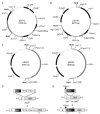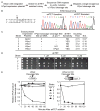A new method to efficiently induce a site-specific double-strand break in the fission yeast Schizosaccharomyces pombe
- PMID: 22674789
- PMCID: PMC3389596
- DOI: 10.1002/yea.2908
A new method to efficiently induce a site-specific double-strand break in the fission yeast Schizosaccharomyces pombe
Abstract
Double-strand DNA breaks are a serious threat to cellular viability and yeast systems have proved invaluable in helping to understand how these potentially toxic lesions are sensed and repaired. An important method to study the processing of DNA breaks in the budding yeast Saccharomyces cerevisiae is to introduce a unique double-strand break into the genome by regulating the expression of the site-specific HO endonuclease with a galactose inducible promoter. Variations of the HO site-specific DSB assay have been adapted to many organisms, but the methodology has seen only limited use in the fission yeast Schizosaccharomyces pombe because of the lack of a promoter capable of inducing endonuclease expression on a relatively short time scale (~1 h). We have overcome this limitation by developing a new assay in which expression of the homing endonuclease I-PpoI is tightly regulated with a tetracycline-inducible promoter. We show that induction of the I-PpoI endonuclease produces rapid cutting of a defined cleavage site (> 80% after 1 h), efficient cell cycle arrest and significant accumulation of the checkpoint protein Crb2 at break-adjacent regions in a manner that is analogous to published findings with DSBs produced by an acute exposure to ionizing irradiation. This assay provides an important new tool for the fission yeast community and, because many aspects of mammalian chromatin organization have been well-conserved in Sz. pombe but not in S. cerevisiae, also offers an attractive system to decipher the role of chromatin structure in modulating the repair of double-stranded DNA breaks.
Copyright © 2012 John Wiley & Sons, Ltd.
Figures





Similar articles
-
A Rapidly Inducible DNA Double-Strand Break to Monitor Telomere Formation, DNA Repair, and Checkpoint Activation.Methods Mol Biol. 2025;2862:209-221. doi: 10.1007/978-1-0716-4168-2_15. Methods Mol Biol. 2025. PMID: 39527203
-
Indistinguishable landscapes of meiotic DNA breaks in rad50+ and rad50S strains of fission yeast revealed by a novel rad50+ recombination intermediate.PLoS Genet. 2008 Nov;4(11):e1000267. doi: 10.1371/journal.pgen.1000267. Epub 2008 Nov 21. PLoS Genet. 2008. PMID: 19023408 Free PMC article.
-
Genetic interactions between the chromosome axis-associated protein Hop1 and homologous recombination determinants in Schizosaccharomyces pombe.Curr Genet. 2018 Oct;64(5):1089-1104. doi: 10.1007/s00294-018-0827-7. Epub 2018 Mar 17. Curr Genet. 2018. PMID: 29550859 Free PMC article.
-
Double-strand break repair and homologous recombination in Schizosaccharomyces pombe.Yeast. 2006 Oct 15;23(13):963-76. doi: 10.1002/yea.1414. Yeast. 2006. PMID: 17072889 Review.
-
[Recombinational repair in Schizosaccharomyces pombe: role in maintaining genomic integrity].Mol Biol (Mosk). 2001 Sep-Oct;35(5):750-63. Mol Biol (Mosk). 2001. PMID: 11605527 Review. Russian.
Cited by
-
Two separable functions of Ctp1 in the early steps of meiotic DNA double-strand break repair.Nucleic Acids Res. 2015 Sep 3;43(15):7349-59. doi: 10.1093/nar/gkv644. Epub 2015 Jun 30. Nucleic Acids Res. 2015. PMID: 26130711 Free PMC article.
-
Telomere-binding proteins Taz1 and Rap1 regulate DSB repair and suppress gross chromosomal rearrangements in fission yeast.PLoS Genet. 2019 Aug 27;15(8):e1008335. doi: 10.1371/journal.pgen.1008335. eCollection 2019 Aug. PLoS Genet. 2019. PMID: 31454352 Free PMC article.
-
Guidelines for DNA recombination and repair studies: Cellular assays of DNA repair pathways.Microb Cell. 2019 Jan 7;6(1):1-64. doi: 10.15698/mic2019.01.664. Microb Cell. 2019. PMID: 30652105 Free PMC article. Review.
-
XPG-related nucleases are hierarchically recruited for double-stranded rDNA break resection.J Biol Chem. 2019 May 10;294(19):7632-7643. doi: 10.1074/jbc.RA118.005415. Epub 2019 Mar 18. J Biol Chem. 2019. PMID: 30885940 Free PMC article.
-
Analysis of DNA Double-Strand Break End Resection and Single-Strand Annealing in S. pombe.Methods Mol Biol. 2021;2153:47-57. doi: 10.1007/978-1-0716-0644-5_4. Methods Mol Biol. 2021. PMID: 32840771 Free PMC article.
References
-
- Bahler J, Wu JQ, Longtine MS, et al. Heterologous modules for efficient and versatile PCR-based gene targeting in Schizosaccharomyces pombe. Yeast. 1998;14:943–951. - PubMed
-
- Berkovich E, Monnat RJJ, Kastan MB. Roles of ATM and NBS1 in chromatin structure modulation and DNA double-strand break repair. Nat Cell Biol. 2007;9:683–690. - PubMed
Publication types
MeSH terms
Substances
Grants and funding
LinkOut - more resources
Full Text Sources
